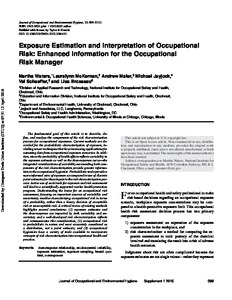Exposure estimation and interpretation of occupational risk: enhanced information for the occupational risk manager

Waters, Martha ; McKernan, Lauralynn ; Maier, Andrew ; Jayjock, Michael ; Schaeffer, Val ; Brosseau, Lisa M.
Journal of Occupational and Environmental Hygiene
2015
12
Supplement 1
99-111
decision making ; dose response relationship ; exposure assessment ; risk assessment ; sampling method ; industrial physician
Exposure limits
http://dx.doi.org/10.1080/15459624.2015.1084421
English
Bibliogr.
"The fundamental goal of this article is to describe, define, and analyze the components of the risk characterization process for occupational exposures. Current methods are described for the probabilistic characterization of exposure, including newer techniques that have increasing applications for assessing data from occupational exposure scenarios. In addition, since the probability of health effects reflects variability in the exposure estimate as well as the dose-response curve-the integrated considerations of variability surrounding both components of the risk characterization provide greater information to the occupational hygienist. Probabilistic tools provide a more informed view of exposure as compared to use of discrete point estimates for these inputs to the risk characterization process. Active use of such tools for exposure and risk assessment will lead to a scientifically supported worker health protection program. Understanding the bases for an occupational risk assessment, focusing on important sources of variability and uncertainty enables characterizing occupational risk in terms of a probability, rather than a binary decision of acceptable risk or unacceptable risk. A critical review of existing methods highlights several conclusions: (1) exposure estimates and the dose-response are impacted by both variability and uncertainty and a well-developed risk characterization reflects and communicates this consideration; (2) occupational risk is probabilistic in nature and most accurately considered as a distribution, not a point estimate; and (3) occupational hygienists have a variety of tools available to incorporate concepts of risk characterization into occupational health and practice."
Digital
The ETUI is co-funded by the European Union. Views and opinions expressed are however those of the author(s) only and do not necessarily reflect those of the European Union or the ETUI.